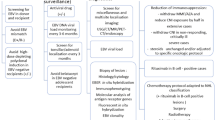Abstract
Introduction
Post-transplant lymphoproliferative disorders (PTLD) are well-recognized complications in solid organ recipients. Limited data exist about the development of PTLDs in living kidney recipients. This study deals with a multicenter nationwide experience with kidney recipients from living donors.
Methods
We reviewed data of PTLD patients from a total population of 6,500 patients transplanted at three different transplant centers in Iran from 1984 to 2006. We also compared their data with 2,250 normal kidney recipients of Baqiyatallah Transplant Center. Data were analyzed to determine potential correlates with the occurrence of PTLD and patient outcome.
Results
Overall, 31 patients were diagnosed as having post-transplant lymphomas. The incidence of PTLD in our kidney transplant population comprised 0.47%. Sixteen (53%) PTLD patients were females, whereas 15 (47%) were males. The mean ages at transplantation and diagnosis were 37.1 and 41.9, respectively. Twelve (63%) patients died, and seven are alive. All deaths occurred within the 1st year after PTLD diagnosis. The mean time period from transplantation to diagnosis of PTLD was 64 (0.7–173) months. Localization of PTLD in the brain associated the worst outcome. Compared to non-PTLD patients, PTLD patients were significantly female predominated (51.6% vs. 32.2%; P = 0.03) and had lower age at transplantation (36.9 years vs. 42.9 years, respectively; P = 0.01). Patients under immunosuppressive regimens containing azathioprine were at higher risk for acquiring PTLDs compared to those with a MMF-containing regimen.
Conclusion
PTLD is a major threat to kidney transplant recipients. Immunosuppressive agents have a significant role in developing the disease. Early detection of the disease and using more safe immunosuppresants may have beneficial effects on patient outcomes and incidence of the disease.




Similar content being viewed by others
Abbreviations
- PTLD:
-
Post-transplant lymphoproliferative disorder
- EBV:
-
Epstein-Barr virus
- CMV:
-
Cytomegalovirus
- KTx:
-
Kidney transplant
- ATG:
-
Antithymocyte globulin
- ALG:
-
Antilymphocyte globulin
- OKT-3:
-
Anti-T-cell receptor monoclonal antibody
- AZA:
-
Azathioprine
- MMF:
-
Cellcept: mycophenolate mofetil
- CNS:
-
Central nervous system
- GI:
-
Gastrointestinal
- LUR:
-
Living unrelated
References
Penn I, Hammond W, Brettschneider L et al (1969) Malignant lymphomas in transplantation patients. Transplant Proc 1(1):106–112
Niaudet P (1998) Postransplant lymphoproliferative disease following renal transplantation: a multicenter retrospective study of 41 cases observed between 1992 and 1996. French speaking transplantation workshop. Transplant Proc 30(6):2816–2817
Trofe J, Buell JF, Beebe TM et al (2005) Analysis of factors that influence survival with post-transplant lymphoproliferative disorder in renal transplant recipients: the Israel Penn international transplant tumor registry experience. Am J Transplant 5(4 Pt 1):775–780
Loren AW, Tsai DE (2005) Post-transplant lymphoproliferative disorder. Clin Chest Med 26(4):631–645 vii. Review
Opelz G (1996) Are post-transplant lymphomas inevitable? Nephrol Dial Transplant 11(10):1952–1955
Cockfield SM (2001) Identifying the patient at risk for post-transplant lymphoproliferative disorder. Transpl Infect Dis 3(2):70–78
Dharnidharka VR, Tejani AH, Ho PL (2002) Post-transplant lymphoproliferative disorder in the United States: young Caucasian males are at highest risk. Am J Transplant 2(10):993–998
Opelz G, Dohler B (2004) Lymphomas after solid organ transplantation: a collaborative transplant study report. Am J Transplant 4:222–230
Penn I (1998) De novo malignances in pediatric organ transplant recipients. Pediatr Transplant 2(1):56–63
Opelz G, Henderson R (1993) Incidence of non-Hodgkin lymphoma in kidney and heart transplant recipients. Lancet 342(8886–8887):1514–1516
Shahinian VB, Muirhead N, Jevnikar AM et al (2003) Epstein-Barr virus seronegativity is a risk factor for late-onset posttransplant lymphoroliferative disorder in adult renal allograft recipients. Transplantation 75(6):851–856
Gandhi MK (2006) Epstein-Barr virus-associated lymphomas. Expert Rev Anti Infect Ther 4(1):77–89
Gandhi MK, Khanna R (2005) Viruses and lymphoma. Pathology 37(6):420–433
Preiksaitis JK (2004) New developments in the diagnosis and management of posttransplantation lymphoproliferative disorders in solid organ transplant recipients. Clin Infect Dis 39(7):1016–1023
Caillard S, Lelong C, Pessione F et al (2006) Post-transplant lymphoproliferative disorders occurring after renal transplantation in adults: report of 230 cases from the French registry. Am J Transplant 6(11):2735–2742
Bustami RT, Ojo AO, Wolfe RA et al (2004) Immunosuppression and the risk of post-transplant malignancy among cadaveric first kidney transplant recipients. Am J Transplant 4(1):87–93
Jain M, Badwal S, Pey R (2005) Post-transplant lymphoproliferative disorders after live donor renal transplantation. Clin Transplant 19(5):668–73
Bates WD, Gray DW, Dada MA (2003) Lymphoproliferative disorders in Oxford renal transplant recipients. J Clin Pathol 56(6):439–446
Cosio FG, Nuovo M, Delgado L et al (2004) EBV kidney allograft infection: possible relationship with a peri-graft localization of PTLD. Am J Transplant 4(1):116–123
Einollahi B, Pourfarziani V, Ahmadzad-Asl M et al (2007) Iranian model of renal allograft transplantation in 3028 recipients: survival and risk factors. Transplant Proc 39(4):907–10
Wimmer CD, Rentsch M, Crispin A (2007) The Janus face of immunosuppression-de novo malignancy after renal transplantation: the experience of the Transplantation Center Munich. Kidney Int 71(12):1271–8
Author information
Authors and Affiliations
Corresponding author
Rights and permissions
About this article
Cite this article
Pourfarziani, V., Taheri, S., Lessan-Pezeshki, M. et al. Lymphoma after living donor kidney transplantation: an Iranian multicenter experience. Int Urol Nephrol 40, 1089–1094 (2008). https://doi.org/10.1007/s11255-008-9377-0
Received:
Accepted:
Published:
Issue Date:
DOI: https://doi.org/10.1007/s11255-008-9377-0




